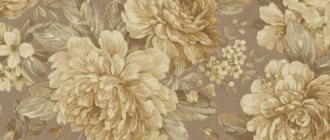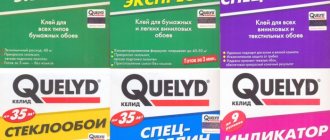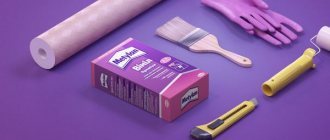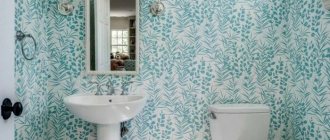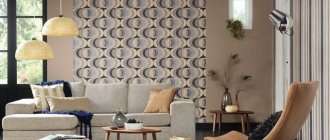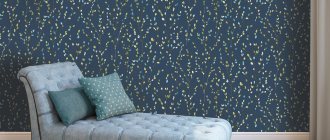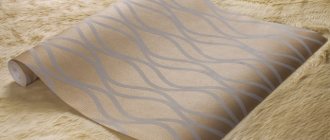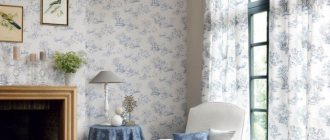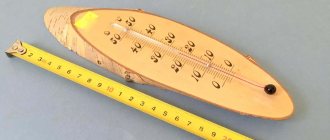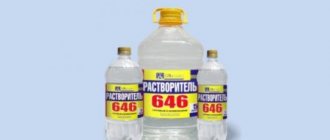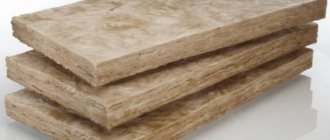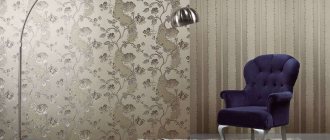When renovating any room, the most important point is high-quality wall finishing. By replacing the wall covering, you can completely change the design of the room. Wallpapering walls is the most popular way to decorate a room. A variety of colors and textures, simplicity and ease of pasting work, accessibility and cost-effectiveness are just some of the advantages of wallpaper over the whole variety of modern finishing materials.
Having made a choice in favor of wallpapering your walls, you need to understand all the advantages and disadvantages of this material, as well as understand the specifics of using each type.
A type of thick wallpaper
In construction stores you can find products on a non-woven basis and completely made from this raw material. The first group is a covering made of vinyl, paper, textiles. The front side material differs in technical characteristics. For example, a paper top side with a non-woven backing quickly wears out and fades in the sun. The main positive difference is that they are environmentally friendly.
Before gluing wallpaper, there is no need to level the walls or repair small defects. You can get by with minimal preparation of the base. The material has a long service life.
Wallpaper gluing technology
Work should begin with the choice of glue. It is recommended to choose a special composition. It has a different consistency (quite thick).
Obvious defects on the walls are eliminated. Then the surface is coated with a primer. Special glue is diluted with water as indicated in the manufacturer's instructions.
Non-woven fabric is cut to a certain length. Be sure to take into account the adjustment of the pattern, if necessary. The adhesive composition is applied to wallpaper and walls. It is necessary to glue the joint end to end.
Important! Non-woven wallpaper can be painted only after complete drying.
When choosing a non-woven covering, you should carefully study the information from the manufacturer and check the product certificate. Thick wallpaper will not only help hide the imperfections of the walls, but will also make them visually more equal. They will please the owners for many years.
What kind of wallpapers are there: All the secrets (1 video)
Source
Classification by technical parameters
There are many characteristics by which wallpaper can be divided into certain types.
One of the most important is the ability to withstand moisture. Based on this criterion, wallpapers are divided into 4 categories. Non-moisture resistant ones are not allowed to be washed; only dusting or wiping with a dry cloth is allowed. Moisture-resistant wallpaper can withstand treatment with a rag or sponge soaked in water, while washable wallpaper can withstand exposure to chemical cleaning agents. The most durable category is considered to be highly resistant wallpaper, which can easily withstand regular cleaning of the surface with a brush. The thickness of the wallpaper is also considered a determining indicator. Dense ones have a long service life, but do not adhere well to uneven surfaces. Thin wallpaper adheres well to the walls, but is short-lived.
The appearance of the wallpaper also plays an important role. Conventionally, they can be divided into types according to the following criteria:
- Design. There are plain wallpapers and canvases with patterns.
- Features of the outer layer. There are:
- smooth;
- embossed;
- with an embossed pattern or ornament;
- wallpaper with deep patterns.
But these are not all the characteristics by which wallpaper can be classified.
How to choose non-woven wallpaper for yourself
Today we will look at how to choose non-woven wallpaper. After all, the choice of “clothing” for the walls of your home is very important; it is the background of the interior, its basis.
The variety of materials can sometimes make your eyes wide open. We’ll look at why you should focus on this particular material and how to choose non-woven wallpaper below. In the photo and video you can see additional information that will allow you to avoid mistakes.
How to make the right choice?
When choosing wall coverings, you should not think about which wallpaper is the best. All types of wall coverings are very different. Study the characteristics of the wallpaper and look at the photos of rooms presented on the Internet. In this case, it will not be difficult for you to choose the type of wallpaper.
To choose the right wallpaper for walls, you need to pay attention to several factors:
- Which room needs to be covered?
- What funds are allocated for the purchase of wallpaper?
- Moisture resistance, sound insulation, breathability and other characteristics of wallpaper, their appearance and the quality of the outer layer of coating.
- Lifespan of the selected wallpaper.
- Match the texture, color and pattern of the selected type of wallpaper to the interior of the room.
It is also important to decide whether to involve qualified craftsmen in the finishing work or to paste the walls yourself.
Why non-woven fabric
This roll material is made from cellulose fibers with the addition of a binder under high pressure and temperature:
Therefore, of all types of wallpaper, non-woven wallpaper can become the golden mean, providing decent quality at an affordable price.
Attention: Calculate non-woven wallpaper not just by length. Also consider the drawing. The smaller the distance between the elements, the lower the waste will be.
Varieties
Non-woven wallpaper can be divided into two large groups: fully made and non-woven wallpaper and made on a non-woven basis.
In addition to these fundamental differences, there is a huge selection of textures and shades. Wallpaper with a pattern made using hot stamping deserves special attention. Vinyl is used as the top layer. The resulting image has a three-dimensional effect.
Basic properties
Non-woven wallpaper is distinguished by the high density and strength of the fabric, this allows them to be very wear-resistant, outperforming their analogues:
Attention: Wallpaper can be removed entirely or layer by layer; in the latter case, new wallpaper can be glued directly onto the remaining bottom layer of the old coating.
| Advantages | It is not without reason that non-woven wallpaper is actively displacing its usual paper counterpart, because they have a number of significant advantages. |
Here are the main ones:
Separation of paper-based wallpaper by strength
- Simplex is a simple single-layer paper tape with a printed pattern. Having low density and inexpensive coating, this type is the cheapest of all types of wallpaper. For a bedroom, children's room or office, thanks to the huge selection of colors, this is a good choice. Before covering walls with such wallpaper, it is recommended to first level and prime their surface.
- Duplex (two-layer) and triplex (three layers) are thicker sheets, usually with an embossed pattern. They cost a little more than single-layer ones, but they hide uneven wall surfaces well.
- Waterproof ones can be used for pasting walls in the hallway or kitchen; they can withstand gentle, without pressure, wiping with a damp soft cloth.
When gluing paper wallpaper, the walls and the canvas itself are coated with the most common glue. Today you can find white textured paper-based wallpaper intended for self-painting.
Characteristics of non-woven wallpaper, features of its composition, care tips
Non-woven wallpaper has deservedly become a favorite type of decorative covering for many. Those who have tried this material in repair and maintenance often advertise it to others.
What are the technical characteristics and beneficial properties of the material? What is the peculiarity of non-woven wallpaper as a finishing material, and the reasons for its wide popularity?
What is non-woven fabric?
Non-woven is a common name for two different types of wallpaper that contain a material called non-woven. In fact, there are wallpapers that are made entirely of non-woven fabric, and a non-woven coating.
What is so special about such an unusual material as non-woven fabric? Anyone who deals with sewing knows that interlining is sewn onto some parts of clothing to make these parts more dense and durable.
Interestingly, it feels like fabric , but looks like paper . So what exactly is its composition and production features?
Read about what types of round interior door handles there are and how to choose the right fittings for interior doors.
Find out about silicone-based paints for painting walls in an apartment in this article. Only the right recommendations from professionals on choosing the type and type of paint for interior work.
The basis of non-woven fabric (70%) is cellulose - the same one that makes up the paper we are used to. Cellulose fibers are arranged in a special way, impregnated with a small amount (30%) of binders.
The components are pressed to form a non-woven fabric. How is it different from plain paper? Greater density, wear resistance and strength.
Specifications
As already mentioned, the main advantage of wallpaper with non-woven fabric is the ability to use it for a long time. The top coating gives the material additional qualities.
Here you can use your imagination to choose what will really decorate the interior.
For gluing such wallpaper, a special glue is used, which differs from that intended for paper wallpaper.
Non-woven wallpaper is heavier , and therefore thicker glue is needed. But it is applied directly to the wall, and not to strips of wallpaper. This greatly simplifies the gluing process. But the surface of the walls should be uniform, because transparent non-woven lining will not hide color differences, as, for example, with selective putty or plaster.
Wallpaper intended for subsequent painting allows you to play with color. Typically, this type of coating is chosen by those who like to fantasize and invent something, or do it themselves.
To paint non-woven wallpaper, water-based paints . They do not contain solvents, so they are safe for health.
As for the non-woven fabric itself, what can be said about its environmental safety? Eco-friendly wallpaper - can non-woven fabrics be considered such?
Since the basis of non-woven fabric is cellulose, it can be argued that it does not cause harm to health. The binding components present in the fabric do not emit harmful substances (formaldehyde) at normal room temperature.
The only danger for allergy sufferers is the dust that accumulates in the textured surface of the wallpaper.
Vinyl
Vinyl wallpapers are paper-based or non-woven. A layer of polyvinyl chloride (PVC, PVC or, more simply, vinyl) is applied to the base. This film is less than a millimeter thick, but it gives the finishing material strength (can be washed with a brush), water-repellent properties, and high resistance to fading. Vinyl sheets can be washed, and many are abrasion-resistant and allow the use of a brush.
This set of properties allows you to use this type of wallpaper in rooms with high humidity, in particular in the kitchen or bathroom, but not in close proximity to water sources. It also works well where high durability of the finish is required (corridor, hallway) - you have to try hard to scratch it.
Another type of wallpaper with special properties is vinyl.
Their main drawback is that they do not allow air to pass through, so they try not to use them in residential premises or compensate by having a good ventilation system.
Types and varieties
Which vinyl wallpaper is better - paper-backed or non-woven? It is easier to glue on non-woven fabric, but only on a well-prepared base. The fact is that thin non-woven fabric is used as a base, and since the vinyl film is also thin, the overall thickness of the coating is small, they are simply not able to hide unevenness - all errors are visible. Another nuance - if the vinyl wallpaper is light, then the base should be a single color, otherwise the uneven color may show through.
If we compare vinyl and other types of wallpaper, they are the best in terms of strength and are easily glued to a relatively flat (maybe not ideal) surface. But, with significant unevenness, difficulties may arise - the dry fabric is glued and it is completely inelastic.
Vinyl wallpaper comes in a wide variety of colors. The surface can be smooth or textured. The design can be simply applied or can have volume (embossed wallpaper). There is also one for painting.
One of the types of vinyl wallpaper is hot stamping (silk screen printing)
Separately, it is worth mentioning vinyl wallpaper, which is produced by hot stamping using silk or artificial threads. They are called silk-screen printing for their characteristic shine. They look very formal, which is why they are often used in living rooms. Some types of silk-screen printing can be seen on the walls in the hallway - they make the room larger with their matte shine.
Vinyl wallpaper is sold in rolls with a width of 53 cm, 70 cm and 105 cm, the length per roll is usually 10 meters (more precisely, 10.05 m), they are glued with a special glue, as they have quite a lot of weight.
Read how to properly glue wallpaper here.
Advantages of non-woven wallpaper
What are the pros and cons of non-woven coating? Undoubtedly, there are many factors in favor of purchasing non-woven wallpaper. Among them, the following can be particularly highlighted:
Wallpaper containing non-woven fabric can be glued even to walls that have minor defects. The structure of the coating itself is such that it can easily hide cracks and irregularities . Of course, this quality will save time and effort to perfectly align the walls.
Since only the wall is coated with glue, there is no need to specially allocate space for applying glue to strips of wallpaper. And due to the fact that the rolls are larger, fewer joints are formed on the surface . The gluing process itself goes faster.
itself does not get wet from the glue and does not stretch . When sticking the strip on the surface, no bubbles form. Working with non-woven wallpaper is very convenient. And they can be glued to almost any surface. You can literally remove old wallpaper in one motion, and there is no need to wet the surface.
On top of that, such wallpaper is quite easy to care for; many of them can be washed, even with the use of detergents.
Carpet wallpaper (tufted wallpaper)
If you want to decorate the walls and floor with carpet, then try using carpet wallpaper with sewn-on pile (“tufted wallpaper”). Tufting means pile, and tufted wallpaper is pile attached to a fabric backing. This decorative finish looks good, absorbs sound and retains heat. This wallpaper is made from 100% synthetic fiber, is insensitive to humidity and relatively fire resistant. They are glued with regular wallpaper glue.
Polina Lichagina Courtesy: www.idh.ru
What are the disadvantages?
Non-woven wallpaper also has some disadvantages. And perhaps, taking them into account, someone will decide that this type of coverage is not entirely suitable for them:
Read about what kind of installation of two-level stretch ceilings is considered professional and what are the features of performing work on installing tension structures.
See photos of door decoration with decorative stone here - simply incredible possibilities for decorating doorways!
The transparency of the non-woven fabric itself has already been mentioned. Therefore, the working surface should be plain or the wallpaper itself should have a darker color so that stains on the walls do not show through.
The glue itself can leave traces, so any excess must be removed immediately when gluing.
The exception is textile wallpaper on a non-woven basis - they are not translucent.
Textile (fabric)
Textile wallpaper is made from paper and non-woven fabric. A woven or braided material made of linen, cotton, viscose, jute, polyester, silk, etc. is glued onto this base. The texture can be smooth, silky, velvety. It depends on the material used and weaving technique. In addition, relief designs can be woven onto the fabric.
Textile wallpaper - looks great, but is expensive
Fabric wallpaper is another type of “breathable” wall decoration, and therefore can be used in living rooms. This is a very beautiful finishing material, but expensive. Even if we compare such not very cheap types of wallpaper as silk-screen printing or natural ones. At the same time, it is demanding in terms of operating conditions - it is afraid of high humidity, fades, and can only be cleaned dry, occasionally using a damp sponge.
There are two forms of release: standard - rolls 10 meters long (width 70-80 cm). Some textile wallpaper (more expensive) is sold by linear metres. Their width is usually 105-120, but there are also wider canvases.
The rules for combining wallpaper are described here.
Features of care
If you maintain non-woven wallpaper in proper condition, this will extend its service life. As a rule, there is nothing complicated in the care itself. So, dust can be removed with a vacuum cleaner or brushed off with a dry brush.
Is it possible to wash non-woven wallpaper? Yes but not all. How and what kind of non-woven wallpaper can be washed?
If the coating can be washed (so-called washable non-woven wallpaper), then the degree of protection against moisture . The three-wave icon indicates that this wallpaper is not afraid of moisture and can be washed with a wet cloth. One wave - wipe wet. The brush symbol means that you can use a soap solution when washing. Thanks to wet cleaning, this coating will always look well-groomed. Embossed non-woven wallpaper cannot be washed.
When repainting wallpaper, even reusable, its structure does not change. But strength and sound insulation increase.
It can be argued that non-woven wallpaper is a practical type of wall covering, suitable for covering walls and ceilings, environmentally friendly and durable.
They are harmless to health and beautiful. With their help, you can create a unique interior and make the room cozy - see for yourself:
Source
Glass wallpaper
Fiberglass wallpaper is a special type of finishing material for painting. They are good because they are not afraid of moisture and can be glued in damp rooms. You just need to choose the right paint. The second positive point is that they can withstand repeated repainting (the highest quality - up to 20 times) and their service life is 20-30 years. Other types of wallpaper are much inferior to them in this parameter.
If you need durable wallpaper that can be painted, choose one made from fiberglass
The disadvantage is that the range is not very large, it has a somewhat “office” appearance, and also that before painting, tiny particles of glass get into the air. It is also worth wearing protective clothing when working. Fiberglass wallpaper is glued with a special glue, which is applied to the wall (read more about gluing walls with fiberglass here).
Wallpaper: how to choose and work with them correctly. Portal experience
The modern market for interior materials amazes with its diversity, but, like decades ago, wallpaper has been and remains the most popular wall decor. They are represented by both budget collections, which are affordable for everyone, and exclusive ones, which the majority of consumers can only look at from afar. However, affordable wallpaper today looks quite presentable, which is why the most common way to “refresh” a room is to re-glue the walls. It would seem that everyone knows everything about this material, but there is never too much information, so let’s look at:
Wallpaper history
Like many others, we owe the appearance of wallpaper to the Chinese, who invented rice paper around 200 BC and used it not only for writing, but also for decorating walls. After more than three centuries, again, one of the courtiers of the Chinese emperor, Tsai Lun, came up with a technology for processing textile waste into paper, which also brought closer the appearance of wallpaper in the paper version we are familiar with. However, the inventor of wallpaper with a repeating pattern is considered to be the Frenchman, Jean-Michel Papillon; in 1675, he used wooden molds to obtain a long pattern on a roll.
This happened in 1778, and in 1785 one of His Majesty’s subjects, Christoph Philipp Oberkampf, invented a machine for printing wallpaper by machine.
Further, technologies were improved, new printing methods were invented, the range of dyes increased, and different design styles appeared. In the twenties of the last century, wallpaper experienced its peak of glory - sales amounted to hundreds of millions of rolls. And with the advent of synthetic substances after the Second World War, which increased the attractiveness and durability of the coating, wallpaper firmly established itself among the leaders in decoration, where it remains to this day.
Standards
At the beginning of the 2000s, the share of exports increased. To enter the international market, the Russian Federation developed GOST 6810-2002 . It came into force September 1 , 2003 .
The basis was taken from the European Union standard EN 233:1999 “Wall coverings in rolls. Requirements for finished paper, vinyl and polymer coatings."
Until this point, the Soviet GOST 6810-86 . But it was clearly not enough for interstate trade.
Types and characteristics of wallpaper
Since its invention, wallpaper has never lost its relevance, but thanks to technological progress, which is advancing by leaps and bounds, today there is a large selection of wallpaper varieties on sale, differing both visually and in characteristics.
Paper wallpaper
The most common and accessible category is reasonable cost, combined with attractiveness and good consumer properties. These natural wallpapers are permeable and environmentally friendly, since no harmful dyes are used in production, and the proportion of chemicals in the composition is minimal. However, the service life of ordinary paper wallpaper is the shortest - after about five years they will simply lose their appearance, even if the coating remains intact. They produce several types of paper wallpaper:
One of the most important criteria for paper wallpaper is density - the weight of the canvas depends on it, how much it will hide the unevenness of the base, and how difficult it will be to work with it. The density of light wallpaper is 110 g/m², medium – 110-140 g/m², heavy – from 140 g/m². Medium wallpaper is considered the optimal option in all respects - it is easier to work with, it is quite elastic and has good hiding power. This is a term used for paint, but can be used in this case, since average wallpaper, like good paint, will perfectly mask unevenness and defects in the wall.
Non-woven wallpaper
Nonwoven fabric is a non-woven fabric resembling paper, formed from cellulose fibers, sometimes it is possible to add polyester fibers to the mass. The main advantage of non-woven fabric, like that of paper, is permeability; the canvas allows air to pass through perfectly, but only if the wallpaper is completely non-woven, both the base and the decorative layer. Like paper, non-woven wallpaper can be smooth, textured, with an embossed or three-dimensional pattern. In addition, they produce decorative and basic ones - for subsequent painting. It is easier to work with non-woven wallpaper, since it does not swell with water, when glue gets on the front side, the pattern does not smear, and when smoothing, it is quite difficult to damage the canvas. Another important property is that even a smooth canvas, due to its dense base, will hide unevenness, of course, within acceptable limits.
Vinyl wallpapers
In fact, only the decorative layer is vinyl, while the base of such wallpaper is either paper or non-woven. However, there is no need to talk about the permeability of vinyl-coated fabric, since it is, although thin, up to one millimeter, a solid PVC film. If we are talking about a textured coating with a three-dimensional pattern, then the thickness is much higher. The main advantage of vinyl wallpaper is durability - they can be washed with a wet cloth, even with a brush, they are difficult to scratch by pets and the younger generation. They are preferred to be glued in damp rooms, in kitchens and corridors - where wear resistance and the ability to do general cleaning are needed.
As for working with vinyl, there are no particular difficulties, but if the walls are full of differences, you will have to work hard, since the dry sheet is applied to the base coated with glue.
Acrylic wallpaper
A new product, which is a paper base on which a layer of polymer is applied, which is typical - dotted, due to which permeability is maintained and strength and moisture resistance are significantly increased. Due to the production method, acrylic wallpapers are always embossed and well mask small imperfections in the walls; they are lighter than vinyl and do not require ultra-resistant thick glue. Unlike vinyl, acrylic wallpaper can be used in residential areas, but should not be used in the bathroom, kitchen, hallway or summer house. They are not designed for high humidity, high traffic and condensation that occurs in unheated rooms. However, they are stronger and more durable than paper ones, and they are often visually superior.
Textile wallpaper
Again, on a paper or non-woven basis, but decorative, the top layer is fabric - linen, cotton, jute, polyester, silk and others. Depending on the characteristics of the fabric, the canvas is smooth or embossed, with a plain pattern or colored patterns that shimmer in the light. These wallpapers are also breathable, look very attractive, but are also much more expensive than all previous varieties. At the same time, the coating is demanding in terms of operating conditions - no high humidity, bright light or wet cleaning.
Glass wallpaper
A special type of finish, produced only in the main category, is a white canvas designed for painting. This is a non-woven fabric formed from the finest glass fiber. Depending on the scope of application, it can be smooth (for ceilings) or embossed (for walls). Cobweb, also called glass wallpaper without a pattern, is sometimes used as a base before gluing other wallpaper and even applying plaster.
The material has good permeability, but it may decrease if you use paint that does not have this property, so when choosing, you need to pay attention to this factor. Considering that the canvas can withstand repeated repainting, this is an excellent option for those who like to regularly transform the room.
Liquid wallpaper
In fact, this is one of the types of decorative plaster - the dry mixture is mixed with liquid, swells, and the paste-like mass is applied to the walls with a spatula or a special trowel. But since the material is made from cellulose and textile fibers, with various additives, the coating is classified as wallpaper. After application, a seamless, repairable canvas is formed on the wall - if damaged, any section can be replaced without creating boundaries between zones. At the same time, the main advantage is preserved - the walls remain permeable, which is why liquid wallpaper is allowed in both bedrooms and children's rooms. But they are still afraid of humidity, so you shouldn’t experiment in the bathroom and kitchen. But in the hallway - why not try it, you just need to leave the bag for repairs. As for hiding power, this variety will hide unevenness and defects, but the base must be properly prepared. To prevent stains of different colors from appearing on a dry wall, not only a regular colorless primer for walls is used under the mass, but also a special, tinted one. Or, as a budget option, pre-paint the walls with water-based emulsion to match the color of the wallpaper.
Natural wallpaper
Although paper wallpaper is also natural, it is made from waste or recycled material. The same category of wallpaper includes primary coatings:
There are also metallized wallpapers - a layer of aluminum foil with a pattern is applied to a paper base. But the foil is protected from external influences by varnish, and it is difficult to classify it as a natural material.
Wallpaper on paper basis
Paper wallpapers owe their popularity to their low price and wide range, environmental friendliness and high breathability. But they have low mechanical strength and are afraid of moisture, so with careful care they will last from 3 to 5 years. However, their short service life can also be considered a positive characteristic. Types of paper wallpaper allow you to simply and inexpensively replace wall coverings and quickly refresh or change the interior of a room.
Based on the density of paper-based fabrics, they are divided into three groups:
- lungs weigh up to 110 g/m2;
- medium with a weight of 110–140 g/m2;
- heavy ones weigh more than 140 g/m2.
Medium-density paper wallpaper is ideal for covering walls. They hide minor surface irregularities and are easy to stick. When applying glue, low-density paper sheets quickly get wet, stretch and spread in your hands, do not hide surface defects, and are difficult to level on the wall. Heavy wallpaper with high density requires a lot of physical effort when working.
How to choose wallpaper
In addition to the fact that the wallpaper should please the household and correspond to the general style of the room, that is, not discord with the ceilings, floor coverings and doors, but be combined, the performance characteristics also have meaning. In addition to the already mentioned permeability and its influence on the field of application, the following properties are important:
Manufacturers indicate all these characteristics on the packaging. It is enough to study the markings to understand what properties this or that wallpaper has.
As for the color scheme and saturation, everything is typical - dark shades are not recommended for dark rooms, light wallpaper visually expands the space.
Naturally, when choosing wallpaper, the functionality of the room is taken into account - the more wear and tear during operation, the stronger and more stable the coating should be. For residential premises and especially children's rooms - only hypoallergenic, safe and natural wallpaper.
